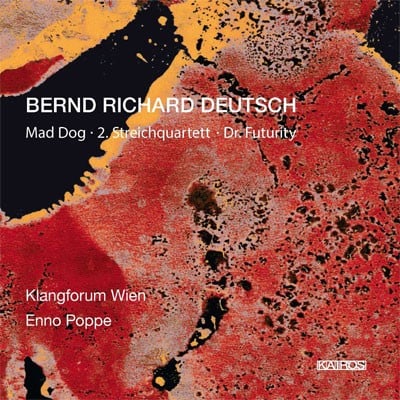1.0.2(II=bcl).Tsax.0-1.1.1.1-perc(1-2)-harp-pft(prep)-2vln.vla.vlc.db
Abbreviations (PDF)
Bote & Bock
I. Incalzante
II. Sognando
III. Irato
Mad Dog was composed in 2011 as a commission from the ensemble die reihe on the occasion of its fiftieth anniversary.
In the scoring of the piece, I consciously dispensed with the oboe and bassoon, or rather replaced them with a second clarinet and a tenor saxophone. For me it was a matter of producing a very specific sound that is lent yet another special color through the use of the harp and prepared piano.
Percussiveness dominates large parts of this work, and the use of preparation materials was a consequence of my search for a percussion-like manner of treating the piano.
On the occasion of the premiere, I wrote the following program text:
"La nature ne laisse à notre disposition, pour établir des distinctions entre les espèces, que des particularités minutieuses, et en quelque sorte puériles." __(For determining the differences between the species nature provides us only with meticulous and somewhat childish details.)
Jean-Baptiste Lamarck, 1817
A piece of music, as if taken from real life... I imagine that the three movements include a 24-hour cycle, starting with the noon and the afternoon (he pushes, pulls, runs, jumps, sniffs, pants, barks, howls, growls, yaps, drinks) throughout the evening and the night (the time of dreams/nightmares and the seemingly irrational, but also the silence) until the morning or the forenoon (anger, conflict, but only temporarily, a fixed idea [chaconne] - end = start).
A zoomorphic play: Man likes to humanize the dog. Or is it rather the dog who „dogisizes" the man? ..."
"Taken from real life" – It was sounds from my everyday life that had an inspirational influence on the composition.
Urging, motor-like rhythms with simultaneous rhythmical flexibility permeate the first movement, which is marked by almost permanent changes of meter.
The apparent "chaos" at the beginning already contains all the essential motifs out of which the music is developed. With reference to a term from biology, one could call it "primeval soup." The string instruments, playing independently of each other, enter gradually, beginning with the first violin. The nearly baroque gesture of the opening motif can possibly be explained from an unconscious associative connection between insistent movement ("incalzante") and motor-like baroque rhythms. However, it is not, as often presumed, a (distorted) quote.
There is a famous painting by the Italian futurist Giacomo Balla from 1912, which bears the title Dynamism of a Dog on the Leash. To be seen in it is a dachshund in motion, which is suggested by the different movement phases of the legs and the tail being simultaneously depicted and in this way overlapping, as if the scene had been photographed with a particularly long exposure time. I remember thinking of this picture often during the work on Mad Dog.
My works – even if they can often be inspired by art, literature, or even just by my everyday life – are ultimately absolute music; they do not have a "program" of any kind. In this piece, too, I was not concerned about the telling of a story or about an illustration, but rather primarily about the depiction of a character whose traits could be described with terms such as energy, the urge to move, and playfulness. A character who is however also distinguished by a certain moodiness and an inclination to choleric outbreaks.
The second movement is a night or dream piece ("Sognando"). Overtone harmonies characterize the beginning. This is followed by a long intensification dominated by glissandos and quick woodwind figures leading up to a dramatic climax that calls to mind a nightmare. The epilogue of the movement circles around a very few chords that increasingly freeze and fade away until only breathing sounds are audible at the end.
At the beginning of the third movement, "Irato" (enraged), it almost seems as if two persons have run afoul of one another, musically characterized by a "threatening" and a "fleeing" element. Surprising then is the middle section: a kind of chaconne develops out of a six-note motif that has the character of a fixed idea; the texture is initially pointillistic, but increasingly grows to nearly orchestral density. After a long cadenza by the prepared piano, a step-dance-like coda concludes the piece in quick tempo.
Bernd Richard Deutsch (translation: Howard Weiner)

Klangforum Wien / Enno Poppe
Kairos 0013352KAI
